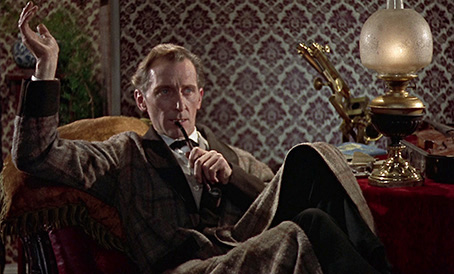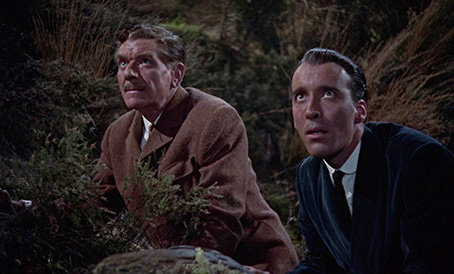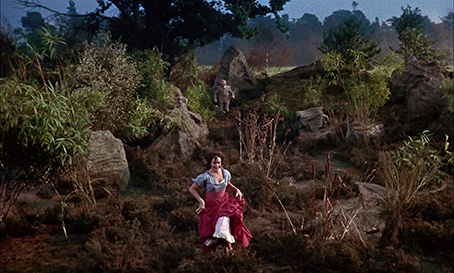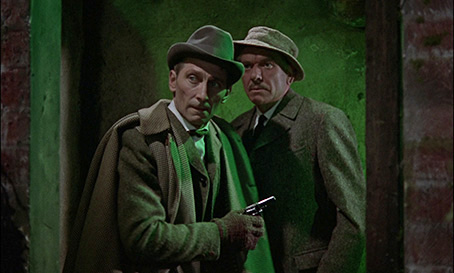|
Of the sixty short stories and four novels featuring Arthur Conan Doyle's celebrated consulting detective Sherlock Holmes, The Hound of the Baskervilles is unquestionably the most famous. It's the one Holmes story that almost everyone has heard of, and while many may not have read it, there's a decent chance they'll have seen one of the thirty or so film or TV adaptations that have appeared over the years. The title has even been absorbed into the English language, to be coined when describing a particularly ferocious dog or one that loudly howls when left on its lonesome.
That the story should be snapped up for a film adaptation by Hammer in the early days of its reinvention as the world's foremost producer of cinematic horror is, in retrospect, not all that surprising. Having hit the box-office jackpot with The Curse of Frankenstein and Dracula and created instant genre stars out of Peter Cushing and Christopher Lee, the Hammer hierachy was clearly looking for projects with an established brand name in which to feature the two actors. Cushing had gone it alone in The Revenge of Frankenstein and his horror reunification with Lee in The Mummy was still a few months down the line, and while not a pure genre work in the mode of Dracula or Frankenstein, this is still a story with strong (if later debunked) supernatural overtones, one that lends itself to the period Gothic that had already become a signature of Hammer's specific brand of horror. And like its studio predecessors, it had a title that the public was already familiar with, and as one of the four Holmes novels it had more than enough plot to sustain a solid feature film interpretation. What could go wrong? Precious little, as it turned out.

A quick bit of plot for the uninitiated few. Sherlock Holmes (Peter Cushing) and his loyal friend and associate Dr. John Watson (André Morell) are visited by Dr. Mortimer (Francis De Wolff), who has travelled from Dartmoor to tell them of the curse that has befallen the eminent Baskerville family, one in which the male heirs fall victim to a spectral hound. The latest to perish is Sir Charles Baskerville, who died of heart failure and was found on the moor with the look of abject horror on his face. Now Sir Henry Baskerville (Christopher Lee), the last surviving member of the Baskerville line, has returned from Johannesburg to take charge of the family home, and Mortimer fears that he may be set to share the fate of his father. Claiming to be currently busy with another case, Holmes agrees to travel to Baskerville Hall at the end of the week. In the meantime he dispatches Watson to watch over Sir Henry, but the pair have not long arrived at their destination before an unearthly howl is heard from somewhere out on the moor.
Where most film adaptations of the novel tend to verbally refer back to the legend that gave birth to the curse, here it is staged with some gusto for the camera, doubtless to give this particular adaptation an appropriately attention-grabbing opening scene. The portrait it paints of the upper class as a morally corrupt and hedonistic band of power-crazed bullies became something of a Hammer trademark (check out the band of loathsome huntsmen in Plague of the Zombies). Here the gleefully unpleasant Sir Hugo Baskerville (David Oxley) tortures one of his servants for the amusement of his awful friends, then offers to pay a lost wager by allowing the winner and his minions to rape the man's daughter. When the girl flees the hall, Sir Hugo chases her onto the moor and murders her with a sacrificial dagger, and is promptly attacked by something large and ferocious-sounding, a creature that terrifies even this beast in human form. For many this sequence will border on parody, but it is worth noting that Sir Hugo was based on the real world figure of Richard Cabell, a 17th-century squire of Buckfastleigh who was described in his day as 'a monstrously evil man'. I'd say Hammer has the awful bastard nailed to rights here.
This explosive opening is not the only liberty this adaptation takes with the novel from which it is drawn. Additional scenes include an encounter with a tarantula spider and an underground cave-in, both of which appear to have been written in solely to up the action quota and accelerate the pace. Not that it needs much of a push here, as in the hands of Hammer's premier director, Terence Fisher, the film rarely pauses for breath. The most potentially contentious alteration for Conan Doyle purists comes with the explanation of just who or what is behind the mystery of Baskerville Hall. Far be it from me to reveal it here, but if you know the story well, don't expect events and even characters to develop quite how they did on the printed page.

Although Christopher Lee's height, bearing and way with icy cool delivery may make him the more obvious choice to play Holmes (he later did in one theatrical feature and two TV movies, and even played his brother Mycroft in Billy Wilder's The Private Life of Sherlock Holmes), Peter Cushing makes the role his own, his precise diction, commanding delivery and busy bits of physical business (Cushing himself was a Holmes devotee) completely cancelling out the shrinking effect of having him play against actors as imposingly tall as Francis De Wolff and Christopher Lee. Cushing even acknowledges the height difference in one of my favourite bits of character business, when he approaches Dr. Mortimer, stands just a little too close when addressing him, and then nudges him down into his chair so that he might continue his discourse from a more authoritative height. He also, for the most part, successfully steers clear of the more common Holmesian clichés, instead bunching them up into a single short sequence to be enjoyed and then discarded – dressed in the trademark cape and deer stalker hat (which the character only wore in two of the stories) and smoking a Calabash pipe, it's only here that he utters that famed phrase, "Elementary, my dear Watson," one that Conan Doyle himself never committed to print.
As the redoubtable Watson, Hammer regular André Morell was apparently determined to portray the good doctor as written and break with the image of him as the bumbling sidekick portrayed for some years by Nigel Bruce. Given that Holmes is absent for a considerable stretch of the story, it's important that we buy into Watson as an intelligent and resilient man, and Morell absolutely nails it, effectively setting the tone for all screen Watsons to come. Frankly, I would have been happy to see a whole string of Holmes adaptations with these two in the lead roles (Cushing later played Holmes in a series of sixteen TV episodes in 1968 with Nigel Stock cast as Watson, but not with quite the fire and drive he displays here).
Lee's casting as Sir Henry is in some ways atypical of his roles for Hammer, and indeed films in general. Although bristling with aristocratic bluff when we first encounter him, a short while later we see him frozen in fear, and later in the story he gets to romance the strikingly attractive Cecille, the daughter of local man Jack Stapleton, making this one of only a small number of Hammer films in which Lee gets to kiss the girl instead of threatening her or hungrily sinking his teeth into her neck. There's some solid work too in a supporting cast peppered with familiar faces, including Ewen Solon as the web-fingered Stapleton, Sam Kydd as expositional coach driver Perkins, Marla Landi as the fiery Cecille, and Dad's Army favourite John Le Mesurier as Baskerville Hall butler Barrymore.

The Hound of the Baskervilles benefits from being made by Hammer's A-team when the formula with which they made their reputation was still fresh and bristling with new possibilities. Director Fisher is at close to the top of his game here, and is well supported by Jack Asher's moody lighting camerawork and James Bernard's vigorous score, which borrows more than a few licks from his chase work on Fisher's Dracula (something Bernard himself was apparently annoyed by). It's a film to which Hound is stylistically bonded, something emphasised by redressing Dracula's castle as Baskerville Hall and the fact that both locations were lit by Jack Asher and set decorated by Bernard Robinson. Actor Miles Malleson even reworks his scene-stealing silly old duffer routine from Dracula, here playing a bishop with fondness for sherry and a rather unusual animal collection. None of which is intended as a slight on The Hound of the Baskervilles, as much of what was great about Dracula also applies here, and the later film never feels feels like a reworking of its forebear.
I'm not going to claim that this is the most faithful interpretation of the Conan Doyle novel, nor that its spectral hound – when we finally get to see it – is anything like as scary as the story demands (I'd hand both honours here to the 1981 Russian adaptation directed by Igor Maslennikov). But its pace and drive and the commitment of its lead performances still make it a winner, and it remains to this day the most energetic and exciting film adaptation of Conan Doyle's rightly celebrated text.
It's getting to the point where I'm no longer surprised by the picture quality on Arrow releases. This is hardly fair, as if I'd been presented with a transfer this impressive of a Hammer film from 1958 a few years ago then my jaw would have hit the floor, but the standard of the Arrow restorations and transfers is now so consistently high that I've come to expect each and every one of them to look the business. Which should not take anything away from the restoration on the transfer here, which was produced by MGM and made available for this release through Hollywood Classics. Framed in its original 1.66:1 ratio, the image displays a consistently excellent level of detail and boasts a richness that allows you to fully appreciate Jack Asher's sometimes gorgeous lighting and Bernard Robinson's carefully textured production design. There's an earthy hue to the daytime interiors, which gives way to cooler tones once night falls, which appears to have been intentional. The more vibrant colours in the opening prologue are vividly rendered and can intermittently be glimpsed later on the brighter costumes. The contrast is generally well pitched, with solid black levels and reasonable shadow detail. The picture is also solid in frame and there are almost no dust spots and no visible damage. Excellent.

The Linear PCM 2.0 mono track has the expected range restrictions and the faint trace of some background hiss in the quieter moments, but is otherwise clear and free of damage. James Bernard's score fares particularly well here.
An isolated music and effects track has been included, which is of similar quality to the above. As ever, its principal interest is to highlight just which of the sound effects were added in post production.
Commentary
I tend to be a bit divided on expert commentaries – the best are enthralling and packed with information, while the worst are an absolute slog to sit through. This, I'm happy to report, is one of the best. Official historian for Hammer Films Marcus Hearn and English Gothic author Jonathan Rigby deliver a busy, entertaining and fact-crammed trip through the film and its production, providing plenty of background detail on the shooting of specific scenes and the careers of just about everyone who makes an appearance in the film. There's so much good stuff here that listing a few of the areas covered would give only the smallest flavour of the range and quality of the content. Consider this an essential companion to the film – if Arrow are planning to release any more film's from Hammer's back-catalogue, they should definitely get these gentlemen on board.
Release the Hound! (30:20)
I always look forward to the retrospective documentaries on Arrow releases and this did not disappoint. Holmes devotee, actor and Sherlock writer Mark Gatiss and our favourite horror expert Kim Newman take us on a concise trip through the great detective's screen incarnations and explore some of the qualities of this film interpretation, while the film's third assistant director Hugh Harlow and its chargehand props man Peter Allchorne share their memories of working on the production. Mask maker Margaret Robinson, meanwhile, recalls in some detail (a now elderly woman with a slow delivery, she is allowed to proceed at her own pace uninterrupted, which I really appreciate) the creation of the hound mask and the process of working with a supposedly vicious dog that fell in love with her from the moment they met. All good stuff.

André Morell: Best of British (19:43)
An enlightening look back at the career of actor André Morell, with worthwhile contributions from authors Denis Meikle (A History of Horrors), David Miller (The Complete Peter Cushing) and Jonathan Rigby (English Gothic), although the prize material comes from Morell's son Jason, who outlines his father's early work and his post-war return to theatre and film, and even talks about his death from lung cancer at the age of 69. Favourite moments in The Hound of the Baskervilles are picked out and illustrated, and as a huge fan of Morell's portrayal of Bernard Quatermass in the original BBC production of Quatermass and the Pit (as, I gather, was its author Nigel Kneale), it's nice to know that the actor regarded it as one of his finest achievements.
The Many Faces of Sherlock Holmes (46:04)
A 1986 documentary, presented and narrated by Christopher Lee and made for American TV by the look and sound of it, that traces the history of Holmes on stage and screen. Despite the slightly tacky presentation (almost everything is underscored with music, including the film clips), this is a mine of interesting information for those not already steeped in the subject, and includes extracts from a number of the films under examination, a fair few of which were new to me. The centrepiece proves to be the Basil Rathbone films, extracts from which run on for several minutes. Which is fair enough, given their lasting popularity, but to have Jeremy Brett's superlative interpretation get little more than a quick mention had me screaming at the screen. There's welcome footage of Conan Doyle himself explaining the inspiration for his most famous creation, and Lee's clear contempt for decision to redub his voice on the German production Sherlock Holmes and the Deadly Necklace is worth tuning in for alone.
Actor's Notebook: Christopher Lee (12:59)
An archive interview with Christopher Lee shot for MGM in which he recalls his work on The Hound of the Baskervilles, which he notes offered him the rare chance to play a romantic lead. He expresses his admiration for director Terence Fisher, was clearly enchanted by Marla Landi, and remembers with some horror the scene in which he had a tarantula placed on his shoulder. Most engaging of all are the details of his friendship with Peter Cushing – his recollection of the last time they met before Cushing's death is genuinely touching.

Hound of the Baskervilles Excerpts (14:36 / 6:24)
The wonderful baritone voice of Christopher Lee reads extracts (including the finale) from Conan Doyle's novel. A treat for the ears, illustrated by Sidney Paget drawings.
Original Theatrical Trailer (1:59)
Framed 1.33:1 and presented in black and white (this was the first Holmes film to be made in colour), it's an interesting sell with some serious spoilers.
Image Gallery
A sizeable collection of publicity shots, front-of-house stills and posters, many of them excellent quality.
Also included is a handsomely produced Booklet that includes an essay on the film by Robert J.E. Simpson, notes on the transfer and a generous collection of stills and artwork.
A spirited film adaptation of a favourite novel and one of the finest films of Hammer's golden period. In their excellent commentary track, Marcus Hearn and Jonathan Rigby describe the film as "a flawed gem", but those flaws are minor and there's so much to enjoy here that few will have any serious cause for complaint. Arrow's Blu-ray release is a joy to behold, a splendid transfer backed by a treasure trove of brilliant extras. It's a marvellous release that comes highly recommended.
|